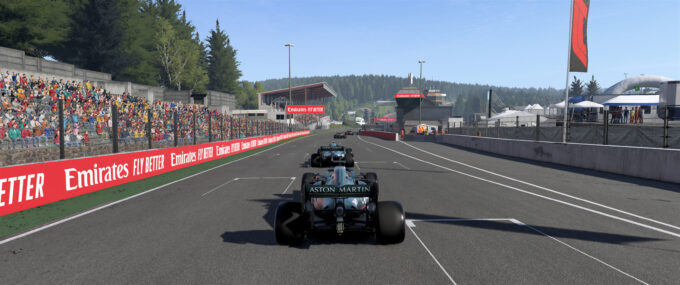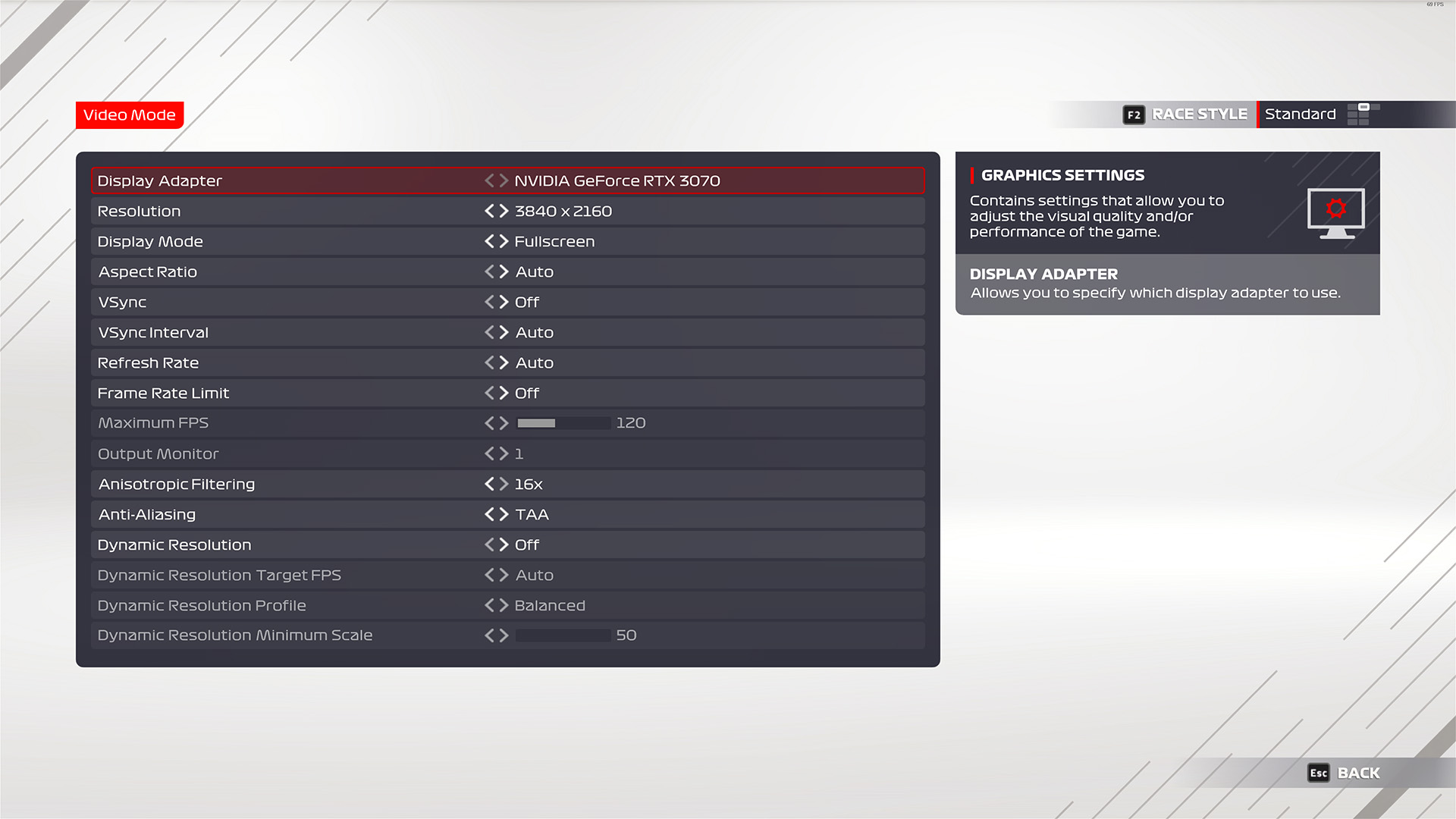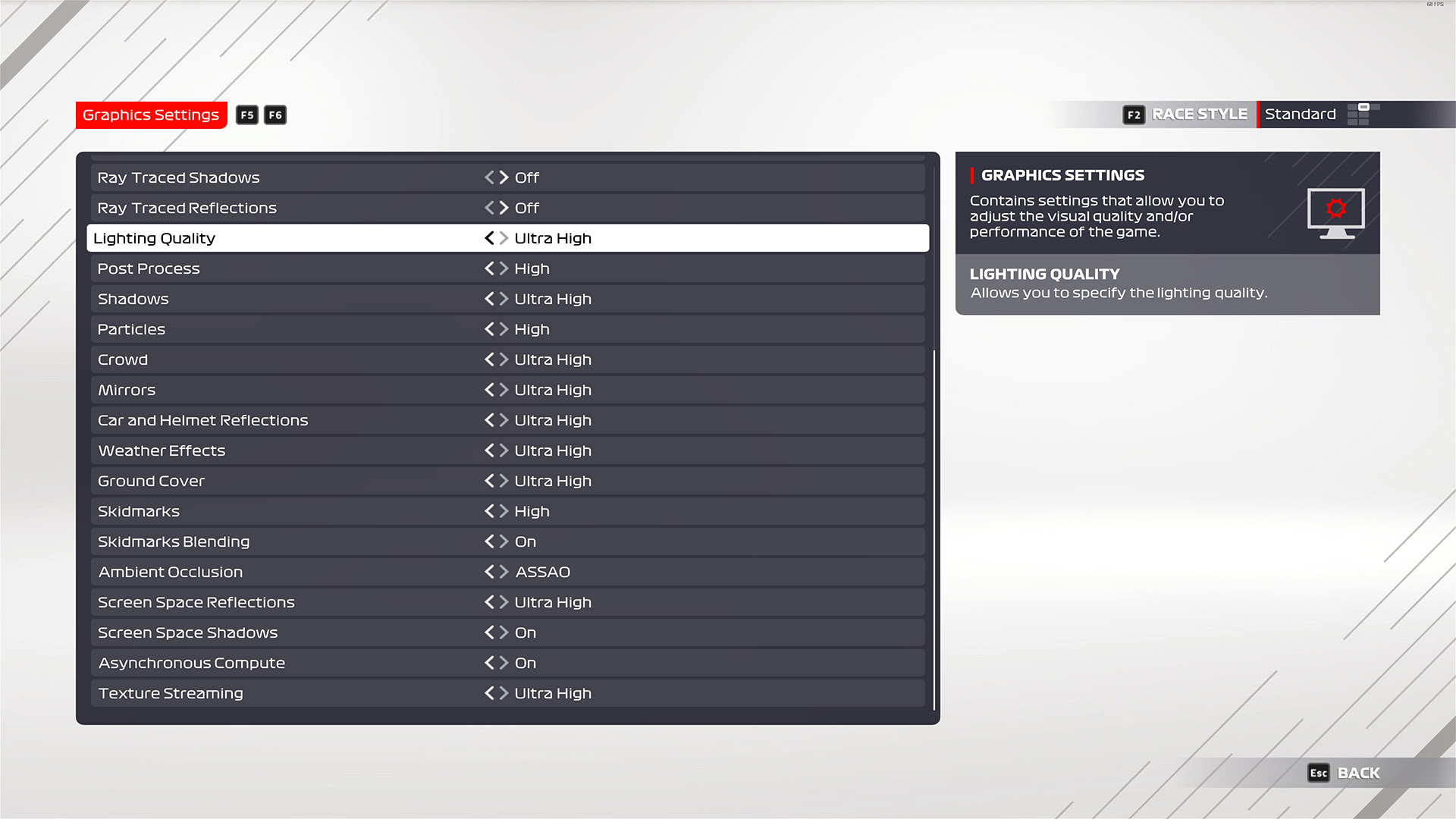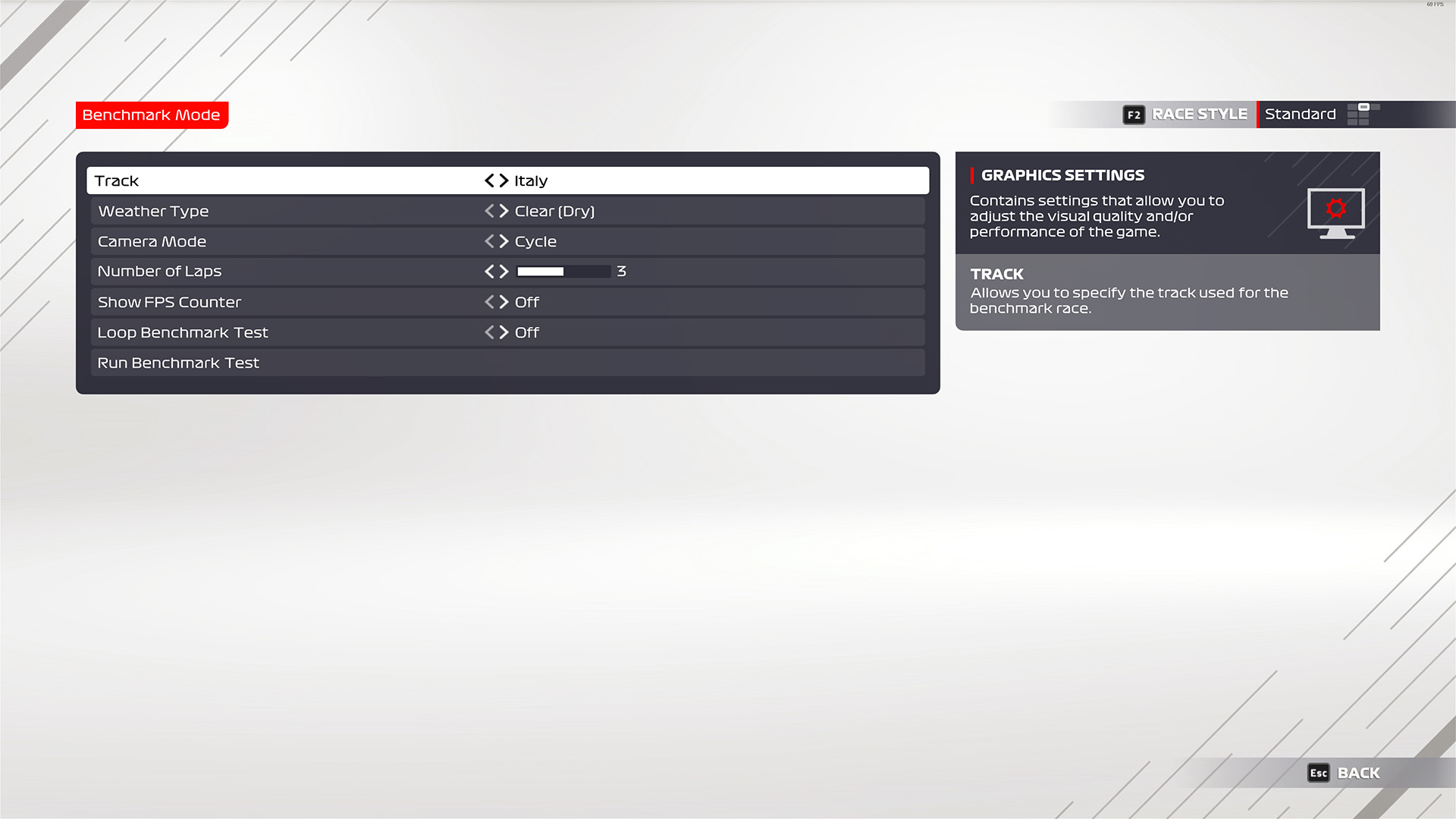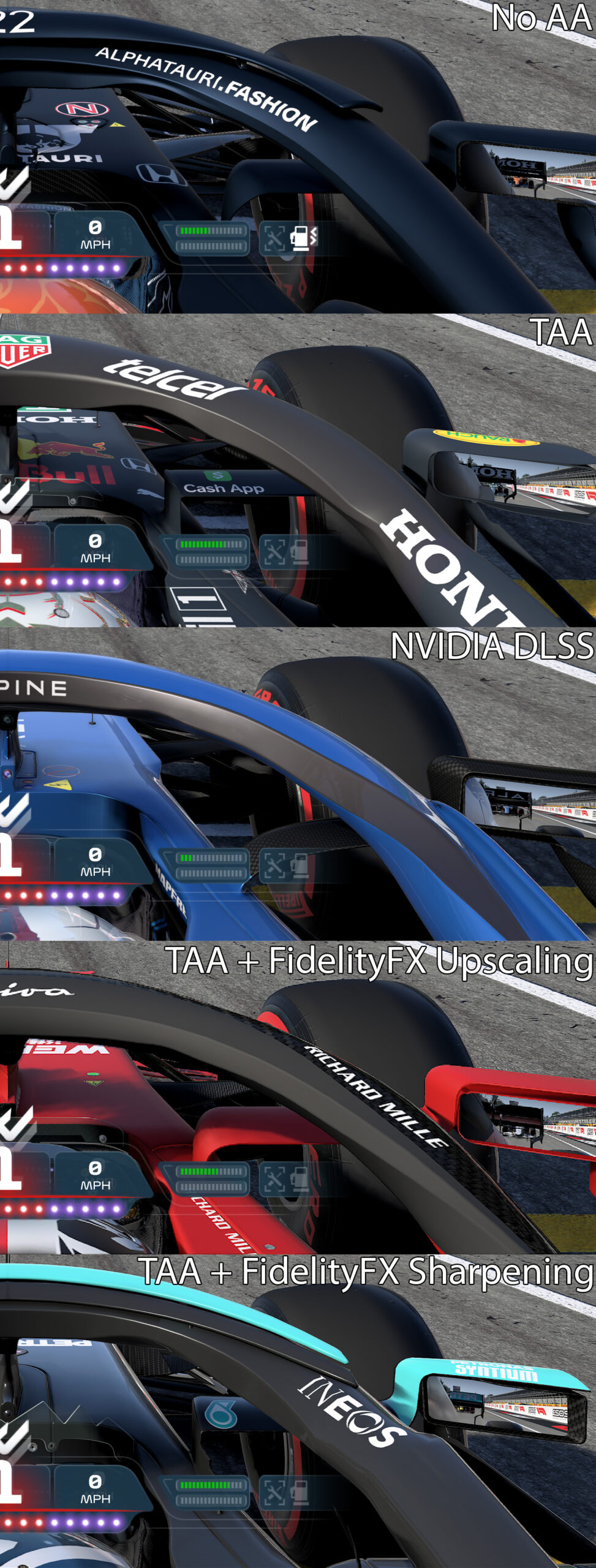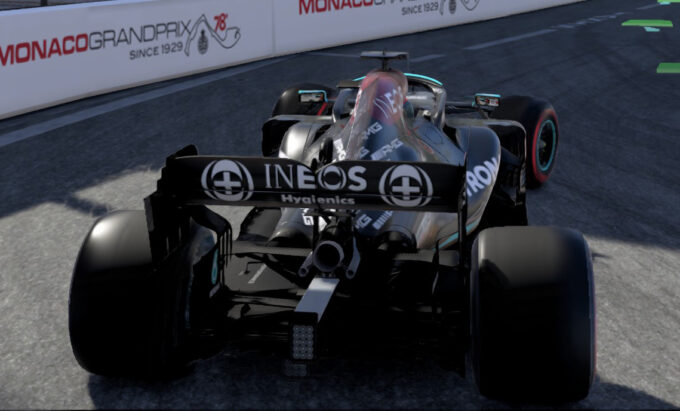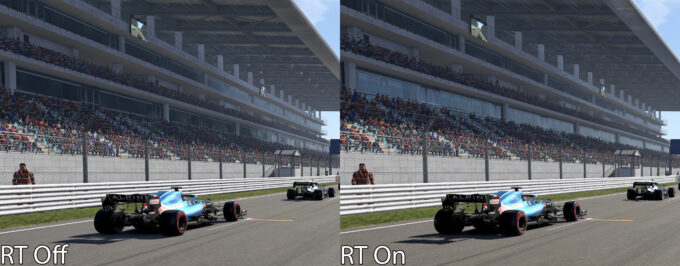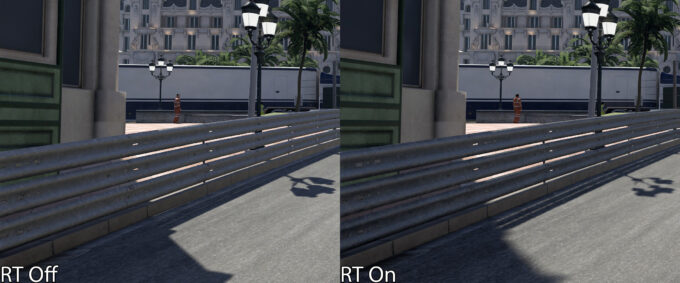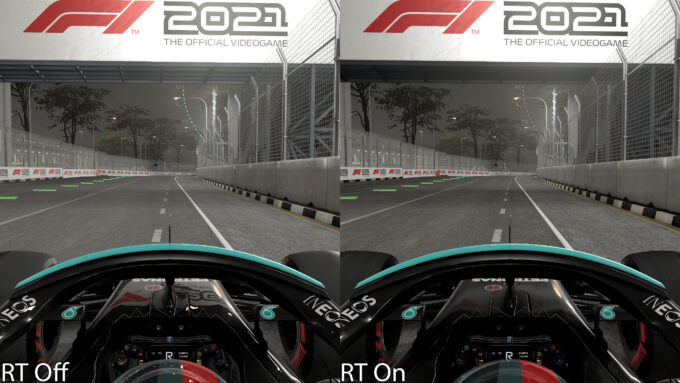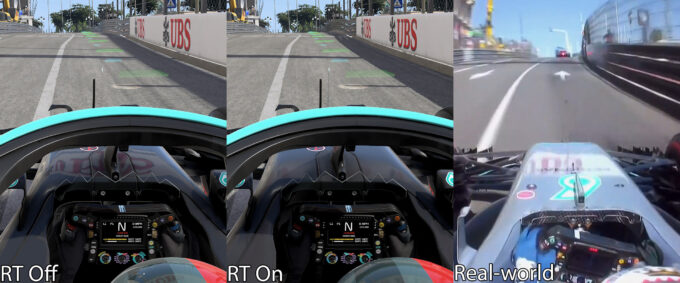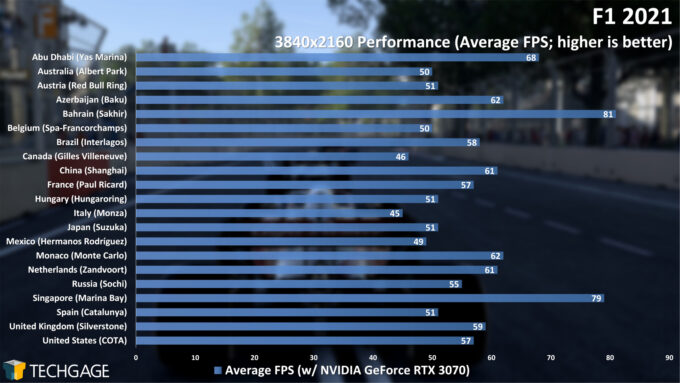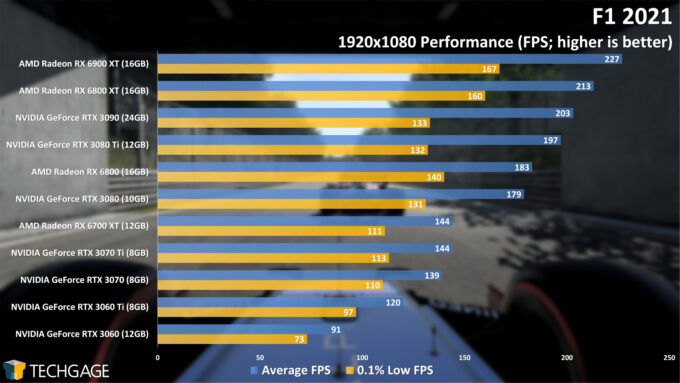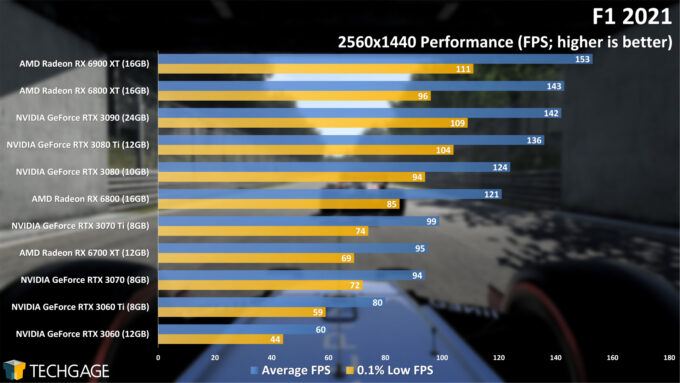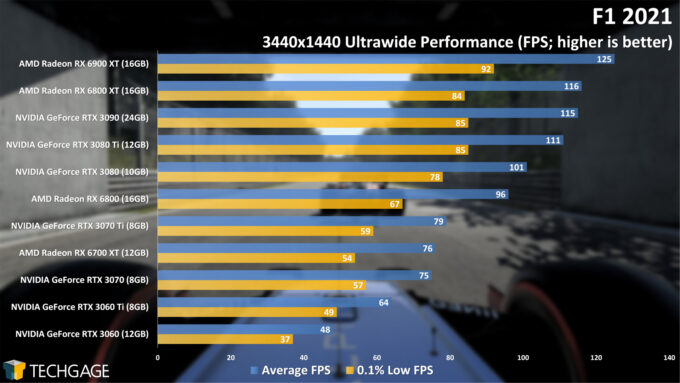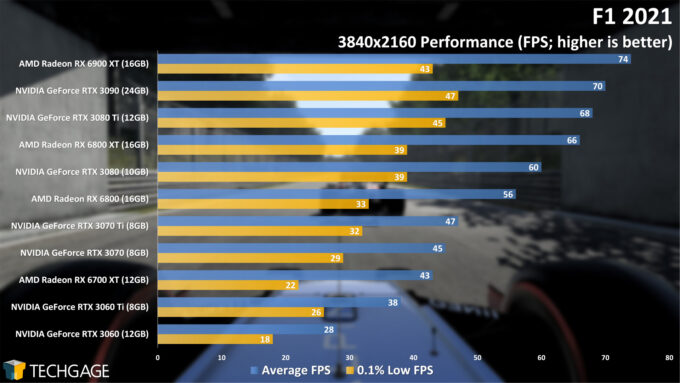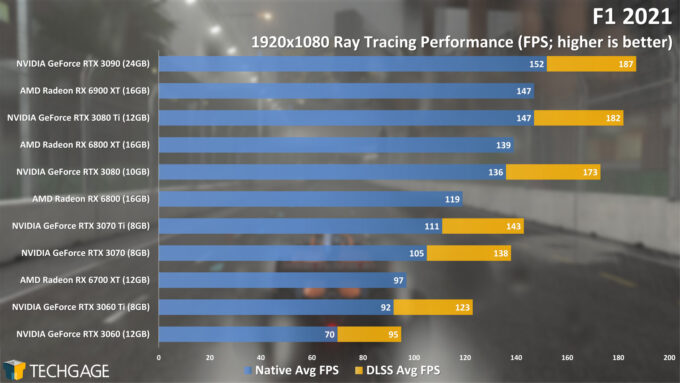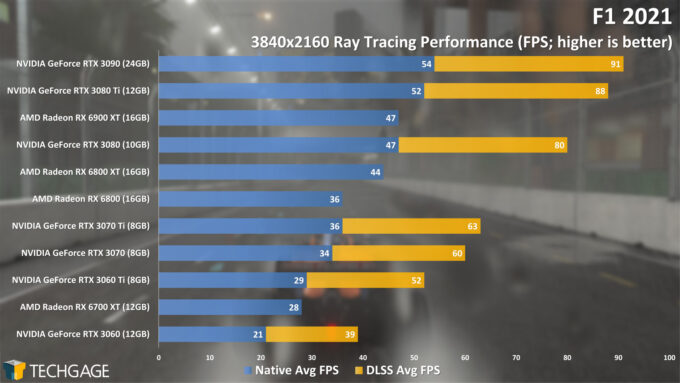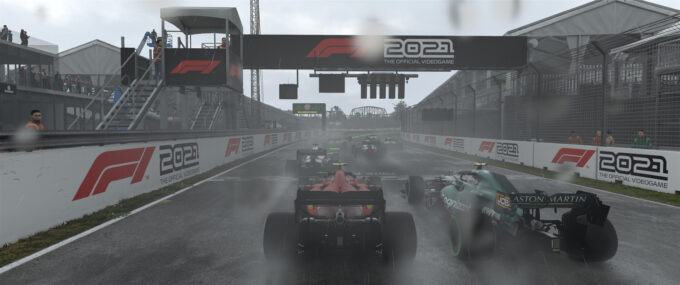- Qualcomm Launches Snapdragon 4 Gen 2 Mobile Platform
- AMD Launches Ryzen PRO 7000 Series Mobile & Desktop Platform
- Intel Launches Sleek Single-Slot Arc Pro A60 Workstation Graphics Card
- NVIDIA Announces Latest Ada Lovelace Additions: GeForce RTX 4060 Ti & RTX 4060
- Maxon Redshift With AMD Radeon GPU Rendering Support Now Available
F1 2021 Performance At 1080p, 1440p, Ultrawide & 4K

Codemasters has just released F1 2021, and for the first time in the series, ray tracing features are offered. For that and other reasons, we decided to dive into a look at both the technical and performance aspects of the game, with plenty of benchmark results to be had at four resolutions with current generation GeForces and Radeons.
As we inch close to the midway point of the ongoing Formula 1 season, Codemasters has let the latest iteration of its tie-in series loose: F1 2021. This update includes current rosters, cars, and tracks in usual modes, as well as a new Braking Point narrative-driven career mode that shares some similarities with Netflix’s popular Drive to Survive series.
In this article, we’re not going to be talking about the game or its modes, or tackle it from a review perspective, since we’ve yet to actually play it. That’s because all of our time spent in the game so far has been tethered to performance testing, and checking out the game’s brand-new ray tracing features – shadows and reflections.
A Technical Look
If you’ve played an F1 title in recent years, F1 2021‘s graphics options are likely going to feel familiar, as will its behavior when setting a quality preset. If you’re using a Radeon GPU, selecting the highest profile will enable ASSAO ambient occlusion, while a GeForce GPU will use HBAO+. For our testing, we use ASSAO across the board, and also enable the screen space shadows option, which is defaulted to off, even when using the highest available preset.
Want to compare your benchmark numbers to ours? You can refer to our reference screenshots below:
By default, F1 2021 uses TAA (temporal) for anti-aliasing, and in all of our testing, we have to say we are really impressed with its quality. We haven’t witnessed the sort of quality loss that afflicts certain TAA titles, and across all of the available AA modes, TAA has proven to be our favorite. Don’t worry – we’re going to show you examples below.
Other AA options include NVIDIA DLSS, TAA + FidelityFX Upscaling, and TAA + FidelityFX Sharpening. When we first saw the FX upscaling option, it was our hope that it was just a funny name for FidelityFX Super Resolution – but not so. It’s actually a really poor upscaling mode that results in harsh graphics detail. The FX sharpening option, meanwhile, looks pretty good, and performs similarly to TAA.
With a close-up look at the cars, here’s a tall image to show you the differences between the AA modes:
Without AA, jaggies are pretty easy to spot all over, while TAA does a good job of smoothing every surface. Note that the cars being different doesn’t really mean much here; the differences will still be easy to spot, and be reflective of any car. NVIDIA’s DLSS looks fairly similar to TAA, which is a good thing.
Unfortunately, the FX Upscaling option fails to smooth the frame, making even the logos on the car look poor. The FX Sharpening mode looks pretty good overall, but in all of our tests, we felt TAA looked better than the rest – and that even includes DLSS. To get a second opinion on AA quality, we go to a classic test: a fence.
At a quick glance, the no AA shot looks pretty good, although it’s still easy enough to spot the jaggies. Where the lack of AA really shows here is towards the right side of the shot, as the fence moves away from the player; it loses lots of detail fast. Again, TAA looks great to us overall, with no noticeable detail sucked away, and crisp lines all over.
Unfortunately, NVIDIA’s DLSS option overly smooths the frame, something you can see easily with the green mesh in front of the camera operator, as well as the Rolex and Zepter banners at the bottom. Depending on your taste, DLSS either makes the trees better or worse. The FX Upscaling option yet again results in a harsh looking frame, while FX Sharpening looks pretty good, but you can definitely tell the frame is being sharpened.
| RX 6800 XT | RTX 3080 | |
| No AA | 69 FPS | 60 FPS |
| TAA | 66 FPS | 60 FPS |
| NVIDIA DLSS | N/A | 100 FPS |
| FidelityFX + Upscaling | 133 FPS | 113 FPS |
| FidelityFX + Sharpening | 66 FPS | 58 FPS |
| 4K Max Detail | ||
On the DLSS front, we’ll see in a bit that using it will in fact improve performance, but with the version of the DLSS .DLL file that ships with the game (2.2.9), ghosting will be really obvious if you use a view outside of your car. This is something really easy to spot in motion, but you can still see an example in a still image, like the one below. Check out the rear light:
If you grab the 2.2.10 version of the DLL and overwrite the one that comes with the game, the ghosting will almost completely disappear. In our testing, we couldn’t really see ghosting at all with the latest DLL, but some folks around the web have said that they can still see it a wee bit. Either way, we’d recommend anyone planning to use DLSS in F1 2021 to grab the latest DLL. Our friends at TechPowerUp have just begun hosting them for easy access.
F1 2021 includes two ray tracing features: shadows, and reflections. After testing RT pretty extensively in this game, it’s hard to say that using it is going to always result in a definitively better image. In some cases, the RT shadows and reflections look really good, but in others, the shadows in particular just don’t look right. Here’s a quick example of RT shadows:
In the shot above, RT off is on the left, and results in soft shadows that look pretty realistic to us. On the right, RT somehow makes these same shadows a jagged, even though the car that’s projecting it is not so. In motion, the RT shadows do look better in general, although these odd shapes creep up once in a while. RT shadows off has its own anomalies at times, however, such as where shadows projected from the tires don’t always look natural (eg: they sometimes look like a beachball is hovering directly next to the car).
Next, take a look at how a building, fence, and lamp post project their shadows:
Looking at the above, we’d have to argue that the RT off shadows look more realistic. RT on for some reason eats away at the shadow projected by the lamp post when you’re not super close to it, and the building shadow is probably a bit softer than it’d be in real-life. To come to these conclusions, we reviewed some real-world footage from the same track (Monaco) during a Formula 1 race.
Fortunately, RT reflections look quite a bit better, improving puddles, windows, and anything else reflective – although there are caveats. In some cases, we feel as though the RT off option looks more realistic, even if the RT on option appears to be better. In the Singapore shot below, for example, you can easily see signage and lights reflected off of the car when not using ray tracing, but enabling it softens the reflection quite a bit.
To illustrate this better, let’s head back to Monaco, and introduce a real-world example:
We’d have to say, when compared to the real thing, RT off looks more realistic. This extends to the helmet, as it reflects lights, buildings, and banners in the real-world as drivers zip around the track.
While we had high hopes for ray tracing in F1 2021, we admit we’re left a bit wanting. The truth is, not even the RT off mode looks right all of the time, so in this game, there really is no “perfect” choice. Both RT off and on have independent qualities that are nice to have. Maybe this will improve in future updates.
A Performance Look
| Techgage Workstation Test System | |
| Processor | AMD Ryzen 9 5950X (16-core; 3.4GHz) |
| Motherboard | ASRock X570 TAICHI (EFI: P4.30 04/14/2021) |
| Memory | Corsair Vengeance RGB Pro (CMW32GX4M4C3200C16) 4x8GB; DDR4-3200 16-18-18 |
| AMD Graphics | AMD Radeon RX 6900 XT (16GB; Adrenalin 21.7.1) AMD Radeon RX 6800 XT (16GB; Adrenalin 21.7.1) AMD Radeon RX 6800 (16GB; Adrenalin 21.7.1) AMD Radeon RX 6700 XT (12GB; Adrenalin 21.7.1) |
| NVIDIA Graphics | NVIDIA GeForce RTX 3090 (24GB; GeForce 471.11) NVIDIA GeForce RTX 3080 Ti (12GB; GeForce 471.11) NVIDIA GeForce RTX 3080 (10GB; GeForce 471.11) NVIDIA GeForce RTX 3070 Ti (8GB; GeForce 471.11) NVIDIA GeForce RTX 3070 (8GB; GeForce 471.11) NVIDIA GeForce RTX 3060 Ti (8GB; GeForce 471.11) NVIDIA GeForce RTX 3060 (12GB; GeForce 471.11) |
| Audio | Onboard |
| Storage | AMD OS: Samsung 500GB SSD (SATA) NVIDIA OS: Samsung 500GB SSD (SATA) |
| Power Supply | Corsair RM850X |
| Chassis | Fractal Design Define C Mid-Tower |
| Cooling | Corsair Hydro H100i PRO RGB 240mm AIO |
| Et cetera | Windows 10 Pro build 19043.1110 (21H1) AMD chipset driver 2.17.25.506 |
| All product links in this table are affiliated, and help support our work. | |
Per-track Performance
In previous F1 testing, we always used Australia’s Albert Park as the circuit of choice, largely because A- it’s a great track, and B- it always came first in the list (remember when Albert Park started the seasons off? Good times.) For this go-around, we decided to run a 3-lap stint of every circuit offered, to see which one proved the most grueling. Let’s check out the results:
You may not have suspected it, but there can actually be a huge performance variation between one track and another. We suspect that trees and foliage are some of the biggest performance hogs, and since the likes of Monza, Gilles Villeneuve, and Spa have tons of that, we can see it reflected in the performance. Meanwhile, a city track like Marina Bay, which has far fewer trees, performs extremely well.
Based on this testing, we chose to conduct the rest of our benchmarking using Monza. Here are those results (with TAA enabled):
1080p, 1440p, Ultrawide & 4K Performance
At 1080p, every single one of the tested GPUs performs great, with even the RTX 3060 hitting 90+ FPS average, and 70+ FPS percentile low. Should you have 144Hz goals, either the RTX 3070 Ti or RX 6700 XT will help you hit that easily enough.
With our 1440p testing, we found that the RTX 3060 was able to hit exactly 60 FPS, which is an important target, although we’d quicker suggest the RTX 3060 Ti instead, since it can ensure 60 FPS as a minimum. If you are after 144Hz for this resolution, only the top-end GPUs will deliver it, at least at our chosen detail levels.
A game like F1 2021 is basically made for ultrawide aspect ratios, and fortunately, you don’t need a high-end GPU to deliver a suitable experience. The RTX 3060 Ti breaches 60 FPS, but if you’re hoping for solid minimums, you’ll probably want to try to get a higher-end model that hovers around 60 FPS at the bottom end. RX 6800 and RTX 3080 and above can hit close to or above 100 FPS.
At 4K with max detail, you’ll really need to go with a high-end GPU for solid frame rates. It takes at least the RTX 3080 to hit 60 FPS minimum. The lower-end GPUs are powerful in their own right, but you’ll need to adjust the quality levels quite a bit to bring them up to acceptable levels.
Ray Tracing Performance
As you would expect, enabling ray tracing decreases your average framerate, but thankfully, the impact isn’t quite as major in F1 2021 as it is in some other titles. If you were worried about RT performance on Radeon with this game, you have nothing to fear: AMD performs quite well. Once again, however, NVIDIA’s DLSS helps change the end result, giving that company’s cards the ultimate lead by a fair margin.
As we covered above, the DLSS .DLL that ships with F1 2021 is one version out-of-date (as of the time of writing), so you’ll really want to source the 2.2.10 version in order to either decrease or completely (it depends on how eagle-eyed you are) get rid of car ghosting. Note that if you don’t care about the ray tracing features, you can still use DLSS – the two are not attached at the hip.
Final Thoughts
As of a week ago, we had no intention to deep-dive F1 2021 like we did here, but when it finally launched, we suddenly had an itch we needed to scratch. Overall, the latest F1 title looks great, although its RT implementation is hit-or-miss, in our experience. As we’ve come to expect, you don’t need top-end GPUs to get great performance at normal resolutions, while you’ll need to go higher if you want go ultrawide or 4K and retain max detail levels.
Throughout all of our performance results, we were quite impressed with how well AMD’s Radeons performed. That even includes the ray tracing tests. While NVIDIA still comes out on top thanks to DLSS, AMD’s performance was really strong overall. It must be noted that we don’t believe the DLSS mode looks as good as TAA, but we’d say it’s the second-best of the bunch, and that extra performance is going to be hard to ignore.
And with that, hopefully this article has helped you figure out which way to go with your next GPU. Should you actually be able to find it on the market, that is!
Support our efforts! With ad revenue at an all-time low for written websites, we're relying more than ever on reader support to help us continue putting so much effort into this type of content. You can support us by becoming a Patron, or by using our Amazon shopping affiliate links listed through our articles. Thanks for your support!




